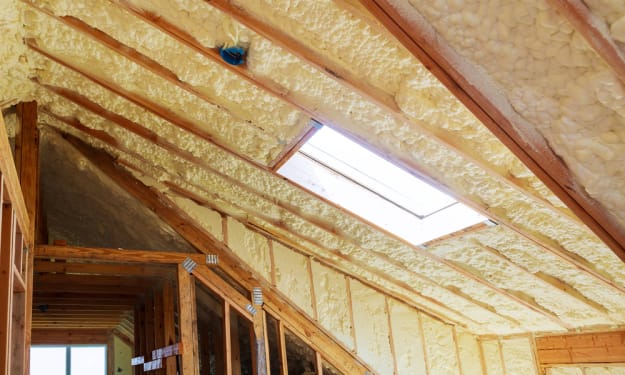The Dangers of Spray Foam Insulation
Dangers of Spray Foam

Exposure to toxic chemicals, nose and eye irritation, difficulty breathing, sinus infection, and fever are all risks associated with spray foam insulation. When installing spray foam insulation, however, you can minimize these negative consequences by wearing protective equipment. In this recent article, you will learn more about various ways how to avoid the dangers of spray foam insulation. Let us throw more light on its expected drawbacks:
1. Toxic Chemical Discharge
Understanding how spray foam insulation is installed might help you anticipate the impact it may have on your health in the future. Spray foam insulation installation is typically done by professionals who have the requisite qualifications and expertise. If not handled appropriately, the chemicals used in spray foam can indeed be dangerous to a person's health straight away. Workers must wear the appropriate protective equipment to protect their eyeballs, mouth, and throat from the isocyanate's harmful VOCs. They avoid getting to grips with the chemicals on their skin at all times. Just after the insulation has been installed, residents must leave the house for at least 2 days.
2. Drawbacks of an Airtight Home
A home with a faultless seal may sound like a homeowner's dream, but it comes with its own set of drawbacks. For instance, airtightness ensures that any moisture trapped inside the house has nowhere to escape. Moisture can cause severe damage to your home if you don't have a sufficient ventilation system, undoing whatever savings you might have made by using spray foam. If you don't have additional systems in place to raise the energy and efficiency saving of your indoor air, it might also cause it to deteriorate. Indoor air pollution can cause a variety of health problems, including skin conditions, stuffy nose, and allergies, to mention a few.
3. Permanence Consequences
You'll be relieved to know that your investment will last for years and will continue to save you money. Spray foam, on the other hand, is nearly impossible to remove, even if it is faulty. If your foam isn't properly sealed or starts to crack as a result of poor installation, you'll have to live with the consequences for a long time. If the negative impacts are severe enough, your residence may become unsafe.
Where not to use spray foam insulation?
A. For regions where electrical boxes are too close:
If you put the foam into the box, the parts will become stuck. Furthermore, you are exposing your electrical box to burnable substances. If you decide to utilize spray foam insulation in this area, make sure it's low-expanding spray foam. Spray foam insulation is highly reactive and combustible.
B. For areas too close to ceiling lightbox
Spray foam should never be used to insulate regions surrounding fluorescent canister lights. You can trap heat and raise the risk of a fire if you pour up near the top of ceiling lightboxes. Even if your recessed canister lights are authorized for intimate interaction with insulation, you might want to talk to a consultant about other options.
C. Avoid when having skin and asthma problems
Exposure to spray foams, which contain highly reactive substances known as isocyanates, can result in serious respiratory and skin problems. When adding the toxins in spray foam insulation into your home's air, you're at an even greater danger of worsening any underlying skin, respiratory, or asthma diseases.
Cons of Spray Foam insulation
A. Spray foam insulation gives substantial assistance to homeowners
If you choose the closed-cell range of new spray foam insulation, you will find that it performs considerably better than some other types currently available. Installers can seal all gaps and corners that would otherwise be exposed because of the product's expanding nature. There is no other technology on the current market that can offer an airtight seal like this one, that's why installation can boost a home's energy efficiency.
B. Spray foam insulation can help homeowners save money
When you choose to spray foam insulation for your building, you can save a bunch of money on your heating and cooling costs. If you place this product in a home or company that doesn't have any insulation, you'll save an average of 50% right away. When compared to other types of insulation, spray foam offers a 30 percent energy reduction. You can even combine this material with other forms of insulation to prevent harmful airflow through your windows, ground, or ceiling.
C. Spray foam insulation creates an airtight, tough seal.
This insulating material expands quickly to fill holes in your basement, attic, and walls. Because they raise the number of power losses, these leaks are frequently one of the most important costs that homeowners confront. When compared to other types of insulation, this product is 24 times less permeable to airflow. It can also go nearly anyplace to provide this benefit.
What Chemicals are used in Spray Foam?
Isocyanates, which are highly explosive compounds, are found on Side A. Side B comprises a polyol, which interacts with isocyanates to form polyurethane, as well as a variety of additional substances such as catalysts, flame retardants, blowing agents, and surfactants.
Isocyanates are found on side A:
• Polymeric MDI, CAS # 9016-87-9
• Generic MDI mixed isomers, CAS #26447-40-5
• 4,4' Methylene diphenyl diisocyanate, CAS #101-68-8
Side B has a specific chemical blend that gives the foam its particular qualities, such as:
• Catalysts for amines
• The Consumer Product Safety Commission has more information on amine catalysts in SPF (CPSC).
• Polyols are a kind of alcohol
• Anti-flame agents
• Agents of detonation
• Catalysts made of amine or metal
• Surfactant
Spray Foam Insulation Risks
When contemplating the use of spray polyurethane foam (SPF) products, those with a history of skin disorders, lung allergies, pneumonia, or prior isocyanate sensitization should read the product information carefully and explore safer alternatives.
Individuals with a history of health disorders such as those stated above will be barred from working with isocyanates, according to manufacturers' isocyanate safety data sheets.
About the Creator
Spray Foam
The Spray Foam Comparison Quotes site is the best Quotes Comparison site for spray foam insulation in UK's, for top contractors. Spray Foam Insulation Cost in the UK can vary depending on several factors.






Comments
There are no comments for this story
Be the first to respond and start the conversation.